A peep of the 3 Baltic states in 2011
Part 2/3
12 - Vilnius, capital of Lithuania
Lithuania is slightly bigger than Latvia, with a population of 3.2 million, made up of 87% Lithuanians, the others are Poles and Russians. It is predominantly Catholic.
Vilnius is the capital, with some 560,000 people. The old town is a UNESCO World Heritage Site. Shown street scenes, last photo taken at the main Cathedral Square on a gloomy day.
Statues and sculptures
First a statue of the Polish poet and freedom fighter Adam Mickiewicz. Next the Monument to Gediminas (1275-1341), the Grand Duke who founded Vilnius, with the dome of the cathedral in the background. Plus two unusual sculptures: the famous "3 Theatre Mules" at the National Theatre of Drama, and a street corner portrait made by punching holes of different sizes and depths onto the plaster.
The Gate of Dawn
The historic Gate of Dawn is one of the 10 city gates built in the 1500s, the only one still standing, 1st photo. On the inner side of the gate is a modern structure with the Chapel of the Gate of Dawn behind the glass windows on the 1st floor, 2nd photo.
Madonna of the Gate of Dawn
The city has a famous painting called "Madonna of the Gate of Dawn" painted in the 1600s. It is kept at the Catholic Chapel of the Gate of Dawn. There are many stories about its miraculous power. It is now covered in gold "clothes" except the face and the hands of the Virgin. People came to the chapel to pray. We did too. Pope John Paul II was here in 1993.
Dominican Church of the Holy Spirit
The 1st version of the church was built in 1408. The last major rebuilding was made in the late 18th century. The design is late Baroque. There are 16 altars, all lavishly decorated with sculptures and ornamentation. The last photo shows a copy of the famous painting “Divine Mercy”.
(Note in 2021: the painting of “Divine Mercy”)
(This painting of a standing Jesus with rays emanating from his chest, is based on a vision by a nun, St Faustina Kowalska, in 1934. The pose of Jesus is an expression of “Divine Mercy”. Most of the Malaysian Catholic churches have copies of the paintings on display.
The first painting of "Divine Mercy" was done by one Kazimirovski based on the personal description by St Faustina of her vision. Later, many paintings of this "Divine Mercy" pose appeared, by different artists.
The original painting by Kazimirovski is housed at the Sanctuary of Divide Mercy, a small building next to the Dominican Church of the Holy Spirit we just visited. We missed this small Sanctuary building due to language problem and in fact thought the painting in the church featured as the last photo above was the original. We were of course very happy at the time of seeing the original painting, like seeing the original Mona Lisa. We discovered the mistake years later. Malu loh.)
Vilnius Cathedral
Construction of the first church started in 1251 after the Lithuanian king converted to Christianity. Due to fire, war, etc, it has gone through several rounds of restoration and additions, the last completed in 1801. It is essentially of the Renaissance style though some decorative elements are Baroque. The 3rd photo shows the main altar and the 4th shows the huge painting at one of the 14 Stations of the Cross.
Other churches
The Lithuanians are fiercely religious. There are some 26 churches in this city of Vilnius alone, most of them Catholics. We visited 2 beautiful red-brick churches of the Gothic design located next to each other. Shown the Church of St Anne with old archaic cast iron doors, and the Church of St Francis and St Bernard showing one of the 3 naves.
13 – Trakai, a resort town in Lithuania
Trakai is a lakeside resort about 28 km west of Vilnius. We made a day trip here. It is famous for its colourful cottage houses and the Island Castle. Big wooden sculptures are spotted in many places. The 1st one is a fireman erected in front of the fire station.
The Island Castle
The castle was built on an island in Lake Galve in 1409 during the reign of Vytautas the Great as the Grand Duke of Lithuania, though work on the castle was started by his father. Vytautas is considered a national hero and he died in the castle in 1430. The castle was fully restored in 1961. The castle, linked by a footbridge, is very photogenic.
Trakai History Museum
Inside the castle is the Trakai History Museum, telling the story of the town and the castles. Authentic items that have seen the great history and notable individuals are on display.
14 - Kaunas, the 2nd largest city in Lithuania
Kaunas is the 2nd largest city in Lithuania, with a population of 280,000. Shown at the main square – the Town Hall Square. The main buildings are the Church of St Francis Xavier in the 1st photo and the Town Hall in the 2nd. The tree is wrapped with advertisement posters for a coming event. Then a shot of the 2-km long pedestrian-only Laisves Aleja, and street lamps and decoration.
Had lunch at a restaurant with their special soup served in an edible container made of bread.
Town Hall Ceramic Museum
Visited the small and niche Town Hall Ceramic Museum. The exhibits are rather unusual and the "style" of presentation of the exhibits unusual too, leaving them on the floor.
Vienybe Square
This is a big square where the Vytautas the Great Museum is located. The Art Deco style museum was open in 1936, 1st photo. Nearby is the Tomb of the Unknown Soldier and Eternal Flame. Next to it is a small cemetery for war heroes. Shown an artistic shot of the tombstones. Shown also coaches of a funicular railway connecting the square to the ground of the Church of Christ’s Resurrection, 85 m above. This is one of the 2 funicular railways still in service. We did take a ride up.
Church of Christ’s Resurrection
This monumental new Catholic church was completed only in 2005 and is the largest church in terms of usable floor area in the Baltic states. One could go up to the flat rooftop to have a panoramic view of the city. The 2nd photo was taken on the rooftop, with the tower on the background rising from the main altar. At the other end of the roof is the 70-m high tower. Very unique design indeed.
Other notable buildings
Several notable buildings: (1) the House of Thunder, a Gothic red-brick secular building constructed in 1440 for a merchants’ group, now a museum; (2) the Church of St Gertrude, another Gothic red-brick building dated to the 15th century; (3) the Church of St Michael the Archangel, a new church completed in 1895 by the ruling Russians as an Orthodox church for the soldiers, hence the domes. It was given to the Catholics after WW1; and (4) the Kaunas Castle dated to the 14th century.
Photo Gallery
For a change, no image of other churches, but some delightful street sculptures.
15 – Siauliai, a small town in Lithuania
Siauliai is a small town in north-west Lithuania famous for the "Hill of Crosses". The crosses were first planted some 150 years ago as a site to remember the fallen heroes in fighting the invaders, and later victims of the Nazis and the Soviet communists. And how many crosses? About 100,000 in 2005 according to Wikipedia. The increase since 2000 is exponential. Should be 150,000 now. The tallest may be 6 or 7 meters. Pope John Paul II planted one in 1993. Only the bigger ones are planted into the ground, smaller ones were hang onto the planted ones. Mostly wooden. A very unique site.
---------- End of tour in Lithuania, now Estonia ---------














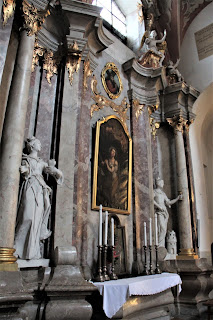
















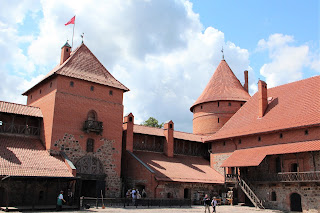







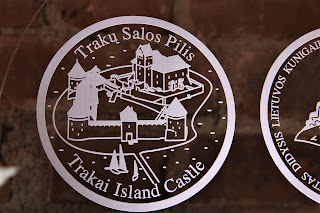



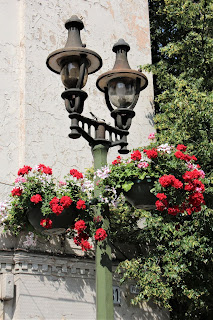




















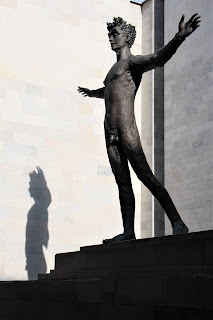







No comments:
Post a Comment